by Tom Gaylord
Writing as B.B. Pelletier
This report covers:
- The test
- Sight-in
- RWS Hobby
- Sig Match Ballistic Alloy
- RWS R10 Match Pistol
- RWS Superdome
- Getting tired
- Air Arms Falcon
- RWS Meisterkugeln
- Something different
- Summary
Today I will test the accuracy of my new/old Beeman P1 pistol.
The test
I shot from 10 meters and rested my hands on a sandbag, but the gun was hand-held. I held it with two hands for the greatest stability. My days of shooting perfect scores one-handed are about over. Instead of 10-shot groups I shot 5-shot groups, but I tried a lot more pellets than usual. I also did something neat at the end of the test.
Sight-in
When sighting in, I started out shooting on high power. The first pellet hit the target very low. I played with the sight adjustments until I got the pellets up into the bull, but a thought occurred to me. What if the pistol did better on low power? That might explain why there is a hesitation going past low power when cocking.
So I shot some pellets on low power and, sure enough, they hit much higher. I ended up putting the rear sight back to pretty much where it had been when I started. I will have more to show you about that at the end of the report.
RWS Hobby
I knew from testing my other P1 that the RWS Hobby pellet does really well in this pistol. Five pellets landed in 0.87-inches. That’s pretty darn good!
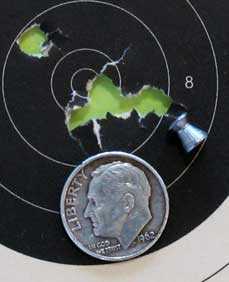
Five RWS Hobby pellets went into 0.87-inches at 10 meters.
Sig Match Ballistic Alloy
Next up were Sig Match Ballistic Alloy pellets. Even on low power they moved fast enough to cut clean holes in the target. Five went into 1.489-inches at 10 meters. That’s a little too open for me. I think this is not the pellet for the P1.
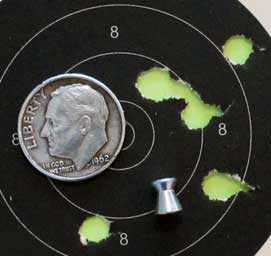
Five Sig Match Ballistic Alloy pellets went into 1.489-inches at 10 meters.
RWS R10 Match Pistol
Next I tried 5 RWS R10 Match Pistol pellets. I guess I was hoping that some of the success I had with the HW55 SF might carry over to the P1. Alas, it doesn’t look like it did. Five R10 pellets went into a very vertical 1.245-inch group at 10 meters. This is another pellet that’s not right for the P1.
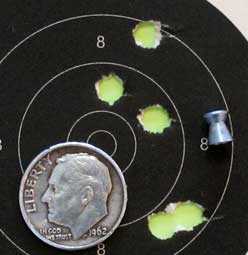
Five RWS R10 Match Pistol pellets made this vertical 1.245-inch group at 10 meters.
RWS Superdome
Next I tried the RWS Superdome pellet. I hoped it would do well, but 5 of them went into a vertical 1.229-inch group. This vertical stringing was becoming a trend. I needed to find pellets that don’t do it.
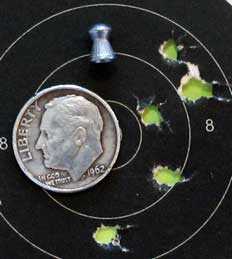
Five RWS Superdomes went into a vertical 1.229-inches at 10 meters.
Getting tired
By this point in the test I was starting to get tired from cocking the gun. So the next group was a surprise, because it isn’t vertical.
Air Arms Falcon
The next pellet I tried was the Air Arms Falcon. These often do well ands I wanted to try them out in this pistol. They did pretty darned good, I think. Five went into a nice round 0.997-inch group at 10 meters. That’s certainly good enough to give them another try down the road.
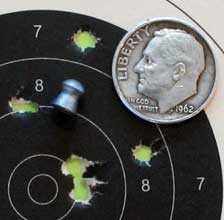
At 10 meters Air Arms Falcons gave a nice round 5-shot group that measures 0.997-inches.
RWS Meisterkugeln
Pressing on with the RWS pellet theme, I decided to try the old favorite RWS Meisterkugeln. Five went into another vertical group that measures 1.179-inches between centers at 10 meters. It’s one of the smaller groups, but the vertical stringing is not to my taste.
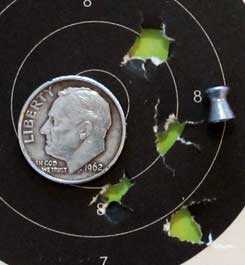
Five RWS Meisterkugeln pellets went into 1.179-inches at 10 meters.
Something different
By this point I was beat and could not trust my ability any farther. But I wanted to try one last thing, so I shot a group of 5 Hobbys on low power and a second group on high power — to see which was better. The high power group printed low on the paper, but at 0.733-inches between centers it’s the smallest group of the day and certainly tighter than the low-powered shots that printed 2-3/4-inches higher. They grouped in 1.211-inches. It looks like high power is the way to go with the P1.
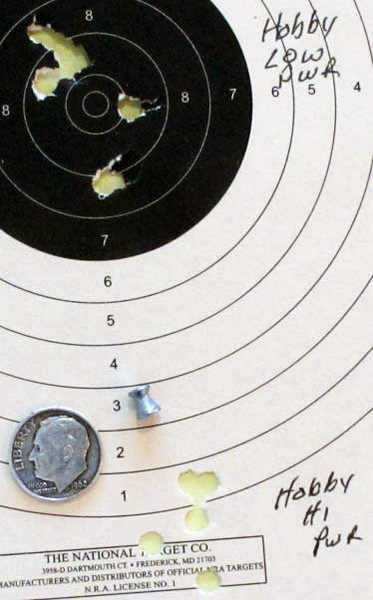
Hobbys grouped much tighter on high power than on low.
The reason the low-powered shots print higher is they remain in the barrel longer and are more affected by the rise of the barrel during recoil. That’s something to think about.
Summary
Now that we have the baseline on this pistol the next step will be disassembly for a look inside. I will decided what comes after than when I see the condition of the parts. Stay tuned!

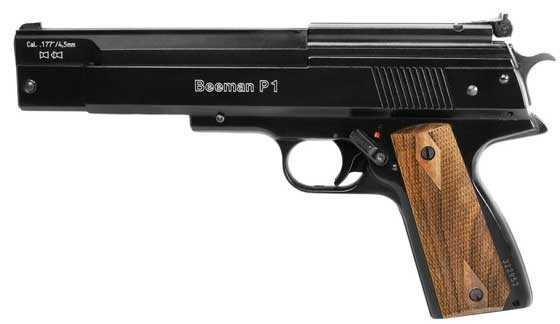
B.B.,
As you shot it more often with high power did the cocking effort get easier? I agree this will benefit more from a tear down rather than just applying TIAT. You may find some areas requiring polishing and an application of moly. I’m interested in seeing the seal’s condition after the two dry fires to seat it.
Siraniko
Siraniko,
You touched on the same things I am thinking.
B.B.
B.B.,
Like Siraniko and you, I am also interested in the state of the seal post dry-firing it twice.
Michael
BB
In relation to the comment about the low power pellets stayed in the barrel and possibly affected the shot.
So maybe a balance could be had using the high power setting and a heavier pellet like the JSB 10.34’s or even the Crosman 10 grain premier pellets.
Hmm. Another way to tune a gun for accuracy and shot cycle.
GF1,
You want your time in the tube as short as possible. Part of that vertical stringing BB was seeing could very well be due to the pellets being in the tube too long during recoil. With a slight variation in time you could have those pellets in quite a line.
RR,
Wow! I never thought of that, and you are right.
B.B.
RR
I don’t think I buy that logic.
Seen too many guns drop one pellet on top of the other when the pellet went slower.
What about what a heavier pellet does to the piston at the end of it’s stroke.
You get a chance try it and post some targets. Are have you already?
Gunfun1,
Are those tack-driving slower air guns low recoil and/or quick lock time, though? Lock time and time in the barrel were both significantly reduced during the dramatic powerplant — and accuracy — revolution in 10 meter competition air rifles from spring to pneumatic. Triggers, furniture adaptability, sights, less recoil, and ability of the competitors all also improved at the same time, but getting the pellet out of the muzzle faster from the moment the trigger breaks was a big factor in the across the board improved scores.
Even with today’s thoroughly recoil-compensated Olympic 10 meter air rifles the minute movement of the shooter affects accuracy less if the lock time and time in the barrel are reduced. The reduced barrel time in these slow-shooting rifles is achieved by shortening the barrels to 16 or so inches.
It’s like Thanksgiving Dinner. The less time cousin Dennis and Grandpa Finney spend in the same room, the less chance of an explosion. ;^)
Michael
RR
Oh and you need to reread my first comment.
I think you misinterpreted my comment.
What I was getting at is you can use different weight pellets to get the right balance of timing for how long the pellet in the barrel.
Plus the vertical stringing could be controlled with a different hold more than likely.
GF1,
OK, keep in mind I read your above comment after posting my comment. :^)
Michael
Michael
There are alot of things to consider in how the pellet leaves the barrel.
Matter of fact that made me think of something I was going to comment about that I found with my FWB 300 I have.
If you remember that gun is modded. It has a heavier single spring in it. I use a o-ring instead of the cast iron sealing piston ring. Got my special top secret spring lube in it. (Note: not really top secret just regular ole white lithium grease). Got o-rings on the two slide rails for dampening.
And yes it shoots better with heavier 10 grain pellets both before and after the tune. But here is what I keep forgetting to say plus I was kind of waiting to see if any one else ever seen this in their FWB 300. You will find when you have the front sight off the barrel that back behind the barrel is that bigger diameter weight. But also bend that weight the barrel diameter is bigger. Guess what the actual barrel is inside that bigger barrel. And guess what else I found the actual inner barrel on mine to be sloppy inside the outer part. You know what I did next. I rested my off hand pointing finger on the smaller actual barrel and held it so it wouldn’t move. Then shot some group’s that way. Oh yeah the group’s tightened up tremendously. My first thought was should I do this next thing. I stood the gun on the butt pad and put about 6 drops of CA glue around the actual barrel. And Super Glue if your wondering what I mean by CA glue.
Anyway yes it was a good gamble. Now the gun does shoot very accurate. But here is what’s related to my comment earlier. The heavy pellets got better. But the lighter pellets got worse groups than they did when the barrel was moving. And remember lighter is faster right. Well apparently tightening up the slop in the barrel made something happen that the lighter pellets didn’t like. And made something happen that the heavier pellets did like.
Wonder if I should be brave enough to say that the lighter pellet could be affected more by harmonics than the heavier pellet in my 300. See there is more to shot cycle than the pellet exiting faster or slower.
I have other examples I could give even with my smooth shooting HW30s. It likes a heavier pellet verses a lighter pellet. Even my QB79 regulated pcp that doesn’t make a move or vibration likes a heavier pellet than a light pellet. And then even both caliber Tx’s tuned and untuned shot better with heavier pellets.
I’m going to have to say it’s more harmonics and timing of when the pellet leaves the barrel like Coduece was saying in a way.
So one step farther the barrel length. Again that’s going to change harmonics when it changes. Here was a thought I had about the Maximus barrel. And again a smooth shooting pcp. First the Discovery’s were pretty accurate. But the Maximus is real accurate. And yes they supposedly changed their barrel making process.
But here’s one for ya. They made the Maximus barrel longer than the Discovery’s barrel. So that means the pellet is in the barrel longer. And I have shot group’s with my Maximus at 800 fps and as low as 600 fps with the same heavy 14.89 JSB pellet and the gun still grouped excellent.
So I would have to say there is more than meets the eye with how long a pellet stays in a barrel. Don’t you think. 🙂
And I did some misspells.
But also (bend) that weight the barrel diameter is bigger.
Should say behind. Not bend.
And should say 15.89 JSB’s. Not 14.89 JSB’s.
Gunfun1,
Don’t forget the biggest factor: the shooter. Getting the pellet out of the muzzle faster matters more with a shaky shooter such as me. That said, I shoot best with my FWB 150, 300s, and FWB 601.
Michael
Michael
Yep for sure the shooter also.
But do you realize what you just said.
“That said, I shoot best with my FWB 150, 300s, and FWB 601.”
All those gun’s you just mentioned are low to zero recoil guns.
Maybe the gun is a bigger part of the equation than thought. 🙂
RR
Forgot something else.
Think about this. I mentioned use high power with a heavier pellet.
So that heavier pellet on high power could actually be going the same speed or possibly a little faster than the medium weight pellet on low power.
Oh heck with it. All we are doing is talking. As it goes. Try it. When the paper hits the target is what will tell the truth.
R.R.
So by recoil do you mean the point where the piston reaches the end of its stroke? With less air to compress due to the shorter stroke, there might be less of a dampening effect at the end of the stroke? The pellet is still in the barrel when the piston reaches its terminus causing the vertical stringing? Sure the piston is moving slower but if the pellet is at the muzzle at just the wrong time I can see how vertical stringing could happen. Is this what you meant? Also wouldn’t the port size be optimized for the high power setting? There is a lot to think about here.
Codeuce
Recoil begins the instant the piston begins to move…when the sear breaks .
I can make my R9s string by holding then in the wrong place .
tt
Coduece,
Like Twotalon says, recoil begins the moment the sear releases the piston.
Using this pistol as an example, when the sear releases the piston moves back toward the shooter and the pistol itself moves forward. When the piston nears the end of it’s stroke, the compressed air usually forces the piston to rebound slightly before coming to rest. This causes the pistol to come back toward the shooter, back forward slightly and then back toward the shooter again. Just to make things interesting you also have the uncoiling spring producing a torque to one side while all of this is going on. At some point the pellet begins moving down the barrel to the muzzle.
This is why sproingers can be quite challenging to shoot.
I found out, decades ago, that my P-1 functions much more accurately with RWS Super Magnum Pellets that were, originally, 9.5 grains. They are now 9.3. However, I also found that I needed to size the pellets and obtained a Giles Pellet Sizer and would size them all. That produced accuracy shooting at the higher power setting.
I never found any accuracy in the low power setting, although I didn’t do the comparative testing as exhibited in Mr. Gaylord’s article, above. My only use for the low setting was to allow the periodic input of RWS Air Chamber Lube into the pistol. I’d put a couple or three drops in the transfer port and then suck it down into the air chamber by going to high power.
LFranke
Does the barrel rise when cocking to load the pellet. If so can you tell if there is any free play in the barrel?
Ok I just clicked on the picture above of the P1. The barrel does lift open.
I’m sure it locks up tight but don’t have one.
I’m going to like when BB takes it apart. Hopefully will get to see some good internal pictures. Definitely looking forward to that.
Gunfun1
I have changed a number of HW45/P1 barrels to be able to shoot my HW45 in 3 different calibers. It’s a simple job that is hard to get wrong. If you find yourself contemplating the use of a hammer when barrel changing, you have it together wrong. A steel plate, with two screws holds the barrel firmly in place so it not only stay’s on, it also gives a perfect seal that maintains maximum compression when the pellet is sent down the barrel. Typical German engineering.
Ciao
Titus
Titus
Maybe that would make the barrel assembly more susceptible to the piston and spring vibration. The cocking arm is a bit different looking setup by looking at pictures. So it’s hard to tell by that. Probably doesn’t affect the shot. But the thoughts there though.
The barrel is located in the top “slide” portion that is the cocking lever. When one releases it by pulling back the “hammer”, it will pop up a bit. I usually slightly compress the “slide” and then pull the hammer back thereby preventing the “slide” from bounding about and minimizing wear on the “hammer” which is the catch.
The “slide” is all metal and the barrel is secured within it by an allen set screw in the front and a steel strap toward the breech end. It closes tightly and the O ring on the transfer port assembly seals to the breech end of the barrel.
I have found a Beeman Pellet Seat tool essential for loading pellets in the barrel. It is no longer made but a clone is now produced, with a convenient lanyard, by RAW down in Tennessee.
LFranke
All the questions I’m asking is not necessarily centered at this pistol.
My thought is that the moving components in the gun. Especially a spring gun. Could cause vibration or movent that could affect the pellet hitting the target.
Maybe it does somewhat. But the question is how much does it affect the shot to make it where you have to hold the gun a certain way to over come accuracy issues.
I myself think something that doesn’t move around is usually easier for me to make my shots more accurately.
My experience is that spring pistols or rifles, regardless of being a gas ram or coil, require some technique to shoot well. The much discussed “Artillery Hold” is essential to allow the piece to bound about as it is wont to do while keeping the POI constant through the shot cycle. The P-1 is fast enough and the barrel short enough that it shoots very well and isn’t to picky about hold. That’s NOT true of some of my other spring pistols.
I’ve been shooting spring guns, long and hand, for enough time that I adapt pretty much automatically to the loose hold. Indeed, the more one tries to subdue the gun by force, the worse the accuracy, as Mr. Gaylord has said repeatedly over time.
Hope this actually answers your question. Hold loose; practice a lot.
LFranke
I have found part of that untrue on spring guns. And yes I have owned some monsters too.
Yes on practice. No not always true on artillery hold. I have had some that like to be held.
Maybe it’s more of ones exsperiance over time and what technique they are use to that actually determines that.
And again one of those subjects that can be debated forever.
All I know is I can shoot a spring gun good. Even not using the artillery hold.
I have an RWS M-36 in .177 that I think one could shoot upside down while riding on a bumpy road and it would shoot straight and well. Doesn’t matter where one’s grips are located or how tight. However, I have an Hatsan M-135 in .25 that is extremely picky about placement and grip pressure. I don’t know why, it just is.
What I have found is that certain fundamentals remain true no matter what one shoots: breathing control, sight picture, avoiding flinch or blink, follow through on the shot, etc. As long as those things are observed, the maters of grip and hold work themselves out.
I will admit that the spring guns are more work. I just purchased a Benjamin 392 (.22) pumper and it is just point, exhale, concentrate and pull the trigger. Easy! I can see why people go PCP!
LFranke
You know what.
I think the longer we shoot we just take things for granted what we do.
I don’t even pay attention to my breathing, or that other stuff.
Matter of fact I just told my daughter today when I was shooting that I’m doing something different. She asked what. And note she shots too.
I said I’m putting my gun to my shoulder. And we did just get through talking about me and Chris USA’s comments about shouldering a gun and line of sight repeatability on today’s blog about scope setup.
What I’m doing now is shouldering the gun getting on target and shooting as fast as I can. The less time I spend before the shot is fired is what I’m practicing now.
So all that tap dancing before the shot is fired is behind me now. Time to move to the next level if you know what I mean.
BB,
OH BOY! We get to see another one’s innards!
GF1,
Let us make an assumption. Everything with the exception of the mass of the two pellets are constant. The heavier pellet is going to require more applied force before it begins to move. Also, because the applied force between the two are equal, the heavier pellet will not accelerate to the same velocity as the lighter pellet. Both of these combine to produce the result of the heavier pellet remaining in the barrel for a longer time, allowing the “recoil” to have a greater affect upon it’s trajectory.
Just to make things more interesting, the different masses, coefficient of friction, blah blah blah have an affect upon the “recoil” itself.
What it boils down to is where I believe you were going is you need to try various pellets and work on your shooting technique to achieve optimum accuracy.
RR
You were replying around the same time as me.
Read my comment I just made above to Michael about barrel harmonics and also I have info in that comment about the FWB 300, HW30s, QB79, the .22 and .177 Tx and the Maximus and Discovery.
And keep in mind that the Maximus now has a longer barrel than the Discovery’s and is more accurate and remember they are smooth shooting pcp’s. And yes I also mentioned that part of the accuracy is probably due to their new barrel making process.
So as I said there’s more to it than meets the eye. And yes your last part of your comment is what I mean.
“What it boils down to is where I believe you were going is you need to try various pellets and work on your shooting technique to achieve optimum accuracy.”
GF1,
I read it after I posted. I was thinking in terms of this pistol and also generally with other sproingers. I had forgotten about barrel harmonics although in this particular case they would just about be meaningless. With a rifle they would indeed become a factor.
RR
I don’t think I would throw harmonics out on the pistol either.
I don’t know how they have the barrel secured on this paticular pistol. But if I remember right it breaks open to cock and the barrel lifts. If so I’m sure that since the barrel is so close to the mainspring and piston that it’s very likely to pick up harmonics. And since the pistol is lighter and smaller than a rifle the harmonics could be transferred more than a rifle.
Yep and in and on we could go on this subject I believe if we keep thinking deeper.
I love airguns!
RR
And me too. 😉
ALL, I was reading all the comments above (very good discussion), my question is, what is lock time? Is it the time from when the trigger was pulled till the bullet exits the barrel? I always thought of lock time as the time between the trigger being pulled and the round moving forward….well sort of like that. Example, in black powder a flint lock takes longer to “fire” than a cap fired bp rifle. So I guess that isn’t lock time, but ignition time? You’d think also that a light weight pellet would reduce the time in the barrel, but in firearms anyway, a faster shooting bullet isn’t the most accurate. It’s lower power ammo that win lots of matches. Example would be 22lr. Most “match” ammo, is standard velocity. Same with 38 special that I’ve shot. Maybe due to reduced recoil? Very interesting to think about.
Doc
Doc
My .22 rimfire rifles shoot more accurately with 710, 950 and 1050 fps long rifle bullets than the 1200 and up velocity rounds.
And not sure if this is right but I always thought with air guns anyway that lock time was from when the trigger was pulled to the time the pellet moves. So that would be a combination of piston stroke and pellet weight and fit.
So then that makes me ask this. Once the pellet moves in the barrel the vibrations of the piston stopping and the spring vibrating would play in to account what the pellet does when it travels down the barrel and exits. To me the more controlled and smooth that gun shoots would help to reduce some of those variables.
To me accurate is smooth.
Doc,
In the case of a springer,… in my opinion,… lock time is when all of the internal “thumpin’ and bumpin'” is done. That said,.. I suppose that there could be the case of the rifle still being in movement, after, the rifle is done moving about (internally). That I would suppose might be more of a case of continued recoil, rather than anything related to what the rifle is doing internally. My 2 cents.
Wondered the same thing when I encountered this term while reading gun magazines as an utterly ignorant teenager. The definition I’ve settled on is that lock time is the interval from when the trigger is released until the firing pin strikes and fires the cartridge. This is supposed to improve accuracy by decreasing the amount of time for the muzzle to move once you take your shot. I think that dwell time in the barrel is defined separately. For one thing, it is considered a property of the load whereas lock time is intrinsic to a gun. Secondly, I don’t think dwell time in the barrel has any significant effect on a shot since it is way beyond human reflexes. Speed of the bullet is more related to flatness of trajectory with all that it implies for accuracy.
A few interesting applications of lock time are that it is, first, much slower for blackpowder. I suppose this is because of the mechanism of the gun and ignition rate of the powder, and this becomes a factor in shooting technique. Another case was the Remington 788 rifle. This was designed as a budget alternative to the flagship Remington 700 rifle, except that it turned out to be extremely accurate. (This is not unlike the F-16 fighter plane that was designed as a cheap alternative to the F-15 but for certain regimes, like pure dogfighting, actually outperformed it in a way that was almost embarrassing.) The accuracy of the 788 was attributed to its very fast lock time. With a cheap price and accuracy, this gun seemed to have it all, but apparently it was discontinued some time ago.
The last instance was an effort to build rifles with an electronic means for firing whose lock time can be magnitudes smaller than a traditional mechanism. I seem to recall some of these rifles being manufactured, but they didn’t catch on. No doubt expense was a factor and maybe the electronics was bumping up against the limit of how lock time impacts the shot, which is to say that it didn’t make much difference.
Matt61
Electronic ignition for rimfire and pneumatic air guns was discontinued mostly because it was quickly banned in competition shooting. Not allowed to use, why make?.
Remington Etronx was discontinued because it was kind of before its time. The expense and lack of catching on because of expense also contributed to its demise.
Silver Eagle
Days of shooting perfect scores one-handed… So, B.B., when you wrote that the Daisy 747 was capable of hitting the head of an eraser 10 times out of 10 (which convinced me to buy that gun), were you speaking from experience? I wouldn’t give up on shooting well into older age. There was a video of some WWII sniper who was gifted with a reproduction Springfield 1903A4 which he shot pretty well. Then, they set him up with a modern M24 sniper rifle and scope and he put five shots into five inches at 1000 yards! The guy was in his 80s when he did this!!
ChrisUSA, if some tiger managed to even the score in self-defense, I wouldn’t hold it against him. But sad to say that tigers are no match for human ingenuity and destructiveness. The story of their elimination in Asia is just appalling. Apparently a good deal of it was done with the .303 Enfield during the British colonial rule although the killing continues. Pigs on the other hand are different story. Eliminating them from some island near South America took a helicopter-borne invasion. On the North American continent they have endless space to roam.
Matt61
Matt61,
My thoughts were to the effect that both tigers and pig hunters existed at the same time, in the same place. Being well mannered pig hunters, they would not be shooting tigers. Then , while the good pig hunters are focused on hunting pigs,.. they could also be unaware that they are being hunted by the tigers. The hunters becoming the hunted. At any rate, all purely hypothetical. Too, how much would a tiger be good for? 1 pig every few days,.. a week? (full belly syndrome) Hunters on the other hand could be good for several per hunter in one day, and the next day.
To me, it seems hog hunting needs to market to the upscale crowd. Fine dining, comfy accommodations, Land Rovers to head out into the field, the finest weapons, custom butchering, shipped fresh to your door. Hey, who does not like bacon? 😉 Since they already go after them with helicopters, why not full autos? That would get some the high rollers interest, I’ll bet. The marketing possibilities seem limitless. Lack of game?,.. not from the sounds of it.
Chris
Chris,
Hogs are fun! Don’t need to be upscale to enjoy the hunt! You mentioned putting a BNM multi shot breech on your Maximus. I have been thinking about doing that with my Disco and adding the Maximus barrel. I installed a free flight hammer and spring tension adjuster and get 20 shots at 9 fps spread at 20 fpe. That’s almost like having a regulator in line. At 225$ shipped for the breech and shroud assembly plus 26$ for the barrel, that’s cheaper than the Gauntlet. But only by $50 ! What is one to do?!!!??
BBB,
Ahhhh,… a man after my own heart! 😉 Sounds like you are having a ball! I did a regulator in mine, which I suspect that you caught from the prior weekend blog. Gunfun1 too. I am happy. Check it out if you missed it. Yup, the mods. are endless it would seem. I would love the Maximus to be a repeater, but a man has to draw the line somewhere, huh?,… maybe not. And yes, enough invested and you have to (should?) ask thy self what else could have been bought? Tweaking and modding is fun though. Good to hear from you! 🙂